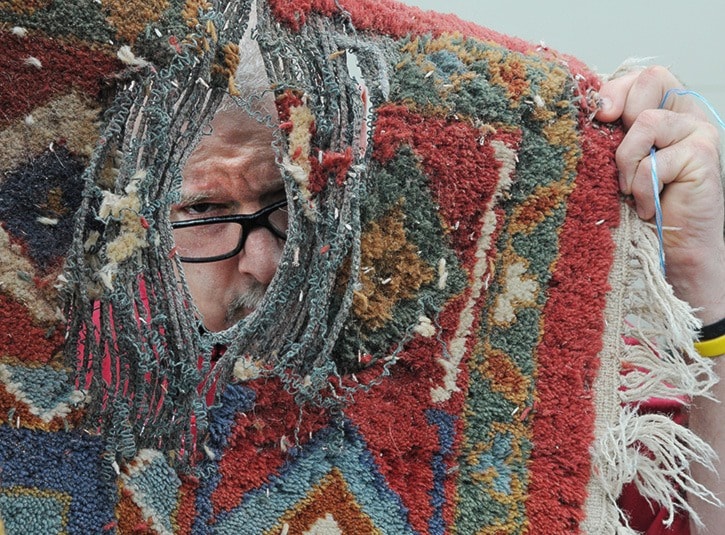Two non-native moth species are eating their way through natural fibre rugs in Greater Victoria at an alarming pace this spring, says one local business owner.
The tiny case-bearing clothes moth and webbing clothes moth like to lay their eggs in dirty fibre before offspring consume and make a nest out of the same spot. Often the damage goes unnoticed until the rugs are cleaned and loose fibres fall out.
“The moths have been getting worse for the last five years, but this year takes the cake,” said Stephen “Dusty” Roberts, owner-operator of Luv-A-Rug cleaning services. “We’re seeing one in every two or three rugs with moth damage. Ten years ago, I’d see maybe one in 100.”
Claudia Copley, entomology collection manager at the Royal B.C. Museum, said the two introduced moth species look for soiled natural fibre in dark places. In rugs, pet urine or excrement sediment is a perfect nesting place for the homebody creatures, which often nest on the underside of rugs to make detection more difficult.
“They just eat any sort of protein-rich material, even a well-worn pair of socks. They get a lot of protein off the oil,” Copley said. “I actually ended up with these particular moths in my home when I brought in an old bird’s nest but didn’t freeze it.”
Freezing is one of the most effective ways of killing unseen moth larvae, Copley said, although frequent inspection and proper storage of clothing and rugs makes a difference as well.
At the museum, staff complete a weekly inspection of window sills and floors to look for any destructive insects that can ruin priceless historical artifacts in a matter of days.
“We also look for hide beetles (or dermestid beetles), which are the bigger problem,” Copley said.
“People will find those in their house too. The most common hide beetle looks like a black and white ladybug, you’ll find them near your windows. They can do significant damage to fabrics.”
Copley couldn’t explain the reported rise in moth infestation, but Roberts believes a decrease in widespread pesticide use may be one factor.
“The other reason is there’s been a lot of travelling rug auctions coming through Victoria in the past few years,” he said. “I’m horrified to see how moth-infested some of those rugs are.
“If you bring one home, your entire house is infested and then you’ve got a much bigger headache.”
Kurtis Brown, technical supervisor at Victoria Pest Control, said he rarely takes calls about moth infestation but he agreed the targeted use of pesticides could potentially help certain insects thrive in homes.
“About 15 year ago, fleas were a huge issue. Flea treatments would consist of broadcast applications across carpets and rugs. Since the invention of systemic pesticide treatments for pets, flea treatments have gone down exponentially,” he said.
Brown said 35 per cent of his business comes from bedbugs, while odorous house ants are a rising concern in Greater Victoria.
“Most people refer to them as sugar ants, and they’re very difficult to control in a large-level urban population,” he said.
In the wild, odorous house ants keep to one queen and a colony of about 100 workers.
But in urban settings, the ants can grow to super colonies several hectares in size.
“And the ants are co-operating, they’re not fighting one another. It’s a huge co-operative colony,” he said.
Brown said areas of Cook Street Village, Blenkinsop Road and Gordon Head in Saanich all house sprawling odorous house ant colonies.
“The homeowners in that area can attest to these insects being the true essence of the word pest,” he said.
While insects can often be seen as the enemy during the late spring and summer months, Copley cautioned against killing every living insect in a home.
“There are almost 3,000 species of moths and butterflies in B.C., and only a couple of introduced species that eat fibres in your home,” she said. “Not all moths are pests. And when the caterpillars start arriving, leave them alone, too.”
dpalmer@vicnews.com
